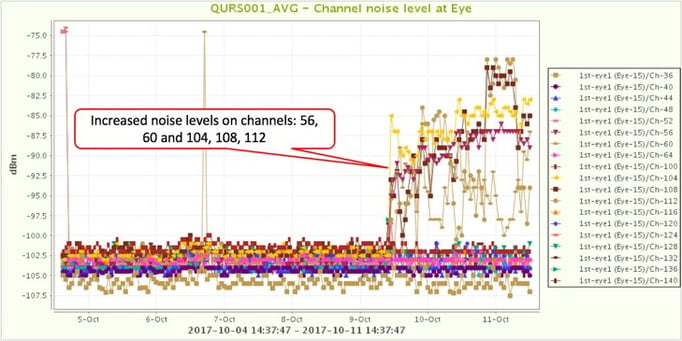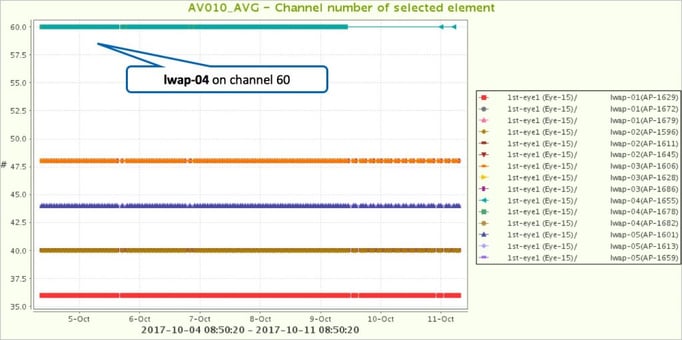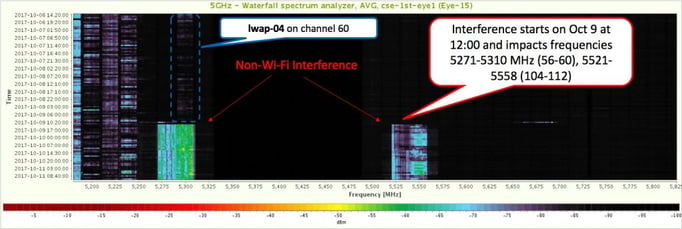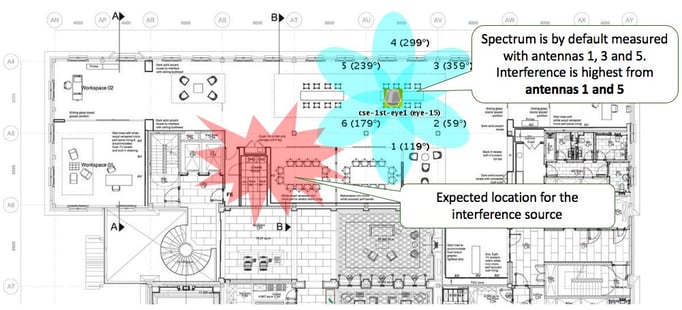Blog
Using our Wi-Fi performance management system, one of our customers recently discovered how their indoor cell phone signal booster was completely trashing their 5GHz spectrum, rendering one poor neighboring access point completely worthless.
How to Improve Indoor Cellular Coverage
Cellular indoor coverage is a common problem. To address the issue, a cellular operator has a few different options.
Increase Power Output
First, they could increase the base station's output power. However, this quickly leads to an unbalanced radio link and an increase in co-channel interference, because when the terminal receives a good signal level from the base station but base station does not receive a sufficient signal back from the terminal, then your connection problems remain.
Adjust Base Station Antenna
Other potential solutions include redirecting the base station antenna, adding more base stations, and finally, you can build-out indoor coverage with a distributed antenna system (DAS) or with more indoor base stations. But none of these are quick and simple alternatives.
Cell Phone Signal Boosters
To address the issue of low indoor signal strength, you can also use indoor cell phone signal boosters. Their job is to receive the cellular signal and then amplify it. Different technologies exist and some of them utilize the 5 GHz U-NII frequency bands for internal system communications. This is problematic because not all of them play by the same set of rules as Wi-Fi. Keep reading to understand how.
Detecting a Problem
Beacon KPI
Our customer received an automated Wi-Fi performance alert from the 7SIGNAL system indicating that access point beacons were no longer detected. The chart below illustrates this perfectly as the Beacon Availability KPI went from 100% to zero. It's important to recognize that the customer's WLAN controller software was not able to detect this.
![]()
Noise Floor
As a next step, we took a closer look at the Noise Monitor in 7SIGNAL as a quick and simple way to detect an increased noise floor. As you can see in the chart below, the Beacon Availability alarm corresponds precisely with a dramatic increase in noise on certain channels. Something is blasting the spectrum on a large swath of channels so hard, that not even beacons can cut through the noise.

Can RRM Help?
We use RRM as general term here for Radio Resource Management. We are NOT referencing any specific Wi-Fi vendor. Our customer was using RRM, as recommended by their WLAN vendor. Most Wi-Fi access point vendors promise that with RF automation enabled, APs will automatically change channels when they detect interference. However, as seen in the chart below, the system indicates that the access point had remained on channel 60 despite the high noise level.

What About a Spectrum Analyzer?
Periodic Spectrum Test
With only a spectrum analyzer, it’s difficult to say whether this new energy is just busy Wi-Fi traffic or something else, because the bandwidth looks similar to 40 MHz Wi-Fi channel. A nice benefit of 7SIGNAL is that it runs a periodic spectrum test throughout the day and night and stores the data for later analysis. Below is a waterfall spectrum graph which shows a significant RF power increase on channels 56-60. The access point named LWAP-04, which is the one that originally alerted our customer with a Beacon Availability alarm, uses channel 60. In fact, the spectrum analysis also shows another band with a similar increase, but luckily in this case, there are no nearby access points using that channel.

Sapphire Eye Spectrum Analysis
The Sapphire Eye 2100 uses an array of six 60-degree directional antennas with spectrum analysis. Therefore, with the help of antenna directivity, the source of the interference can be located. An integrated compass allows for correlating antenna numbers with the customer's office layout. With this technique, it's clear to see in the spectrum chart below that interference is strongest between antennas 1 and 5.

Cel-Fi Signal Booster
At this point, all the network engineer has to do is go to the location and make a visual inspection. When he does, he finds a Cel-Fi cellular repeater is being used for indoor cell phone signal boosting. Not known to our customer... the Cel-Fi repeater found uses the 5 GHz band to communicate between the Network Unit and the Coverage Unit. It also has an output power of 115mW (20.6 dBm). More importantly, it uses a proprietary technology which does not follow the Wi-Fi Listen-Before-Talk principle.
Negative Impact of Heavy Channel Energy
As a result, it blasts the spectrum continually and the channels are heavily loaded with energy that cannot be decoded by a Wi-Fi transceiver.

Decrease in Beacons
Due to the high non-Wi-Fi energy, the access point in the area holds back sending its beacons. Even if the beacon is occasionally sent, it’s completely corrupted by the high energy levels in the same band. So, no Wi-Fi service is possible on that channel near the indoor cell phone signal booster.
Poor Wi-Fi Performance
Wi-Fi performance is also degraded in the surrounding APs that are using the impacted channels, because if a client cannot detect beacons from the nearby AP, it will try to use the next best AP. This leads to low signal level, poor connection quality, and roaming problems.
To the credit of Cel-Fi, they warn that Wi-Fi may interfere with their repeater and suggests making sure that Wi-Fi frequencies do not overlap and interfere with the repeater's internal link frequencies. Cel-Fi states the following:
"The good news is that these two devices can live in harmony by using these steps:
- With the Cel-Fi boxes connected, turn off your WiFi Router and then power back on. Your router should then select vacant 5GHz channels.
- If over time this does not fix the problem, then your router should have the ability to manually select channels. Try to select channel 149 (5735MHz) and above, as Cel-Fi does not use these."
Lessons Learned
- 5 GHz is no longer a safe haven. There is an increasing amount of non-Wi-Fi services using 5 GHz band.
- Your RF automation may fail to meet your expectations.
- A spectrum analyzer alone will not detect certain issues.
- Without proactive visibility into Wi-Fi performance, some issues may go undiscovered for long periods of time, ruining the Wi-Fi experience for employees and customers - let alone driving a wireless engineer crazy.
- If this gives us any taste of LTE-U’s impact on 5 GHz Wi-Fi performance, then we are in for a rough road ahead.
Here are some links to some 7SIGNAL whitepapers that you may also find helpful:
10 Factors Affecting Wi-Fi Performance